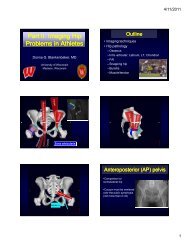Ankle and Foot 47 - Department of Radiology - University of ...
Ankle and Foot 47 - Department of Radiology - University of ...
Ankle and Foot 47 - Department of Radiology - University of ...
You also want an ePaper? Increase the reach of your titles
YUMPU automatically turns print PDFs into web optimized ePapers that Google loves.
<strong>47</strong> <strong>Ankle</strong> <strong>and</strong> <strong>Foot</strong> 2239 <strong>47</strong><br />
Figure <strong>47</strong>-41. Non–weight-bearing radiographic<br />
ankle series in a 37-year-old with lateral ankle pain<br />
after an acute inversion injury. Anteroposterior view<br />
(A) <strong>and</strong> mortise view (B) demonstrate a normal<br />
appearance <strong>of</strong> the ankle joint. C, The lateral ankle view<br />
reveals no abnormalities <strong>of</strong> the hindfoot. (The region<br />
outlined by the dashed rectangle is magnified <strong>and</strong><br />
displayed to the right). Close inspection <strong>of</strong> the base <strong>of</strong><br />
the fifth metatarsal on the lateral view <strong>of</strong> the ankle<br />
reveals a proximal diaphyseal fracture, a Jones<br />
fracture (arrow). Fractures <strong>of</strong> the base <strong>of</strong> the fifth<br />
metatarsal <strong>of</strong>ten present clinically as lateral ankle<br />
pain. The technologist must be careful always to<br />
include the base <strong>of</strong> the fifth metatarsal on at least one<br />
view <strong>of</strong> all ankle radiographic series.<br />
A<br />
B<br />
C<br />
the source images. Because <strong>of</strong> its volumetric nature, helical<br />
data can be reconstructed at any slice width, <strong>and</strong> with any<br />
interval spacing between slices. These axial source images<br />
can then be reformatted into two-dimensional slices in any<br />
desired plane <strong>and</strong> <strong>of</strong> any desired width, or into threedimensional<br />
volume-rendered images. In the past decade,<br />
single-slice helical scanners have evolved into multislice<br />
scanners, able to acquire larger volumes <strong>of</strong> patient data<br />
with each gantry rotation. This technology has largely been<br />
driven by the desire to scan the entire chest within a single<br />
breath-hold <strong>and</strong> the coronary arteries in a single heartbeat.<br />
Although a multislice CT scanner is not absolutely required<br />
for bone CT, covering the desired volume faster minimizes<br />
artifacts related to patient motion as well as minimizing<br />
the amount <strong>of</strong> time the patient has to lie still on the<br />
scanner table.<br />
Thus, the modern bone CT scan consists <strong>of</strong> the acquisition<br />
<strong>of</strong> three sets <strong>of</strong> imaging data. The raw data tend not to<br />
be archived; they are temporarily stored on the scanner’s<br />
hard drive <strong>and</strong> are overwritten as the hard drive becomes<br />
full (<strong>of</strong>ten after 24 hours). The source images are reconstructed<br />
from the raw data using a variety <strong>of</strong> filtered backprojection<br />
algorithms. These images are oriented in a plane<br />
axial to the scanner gantry. Once the raw data are overwritten,<br />
no additional source images can be reconstructed;<br />
thus, it behooves the CT technologist to create whichever<br />
source image data sets are needed for future reformats.<br />
These source images can be viewed by the radiologist as<br />
desired <strong>and</strong> can be sent to the picture archiving <strong>and</strong> communications<br />
system (PACS) for short- or long-term storage.<br />
However, the multiplanar two- <strong>and</strong> three-dimensional images<br />
reformatted from the source images are the ones primarily<br />
used for diagnostic <strong>and</strong> planning purposes <strong>and</strong> ultimately<br />
sent to the PACS for archiving.<br />
Achieving the highest-resolution two-dimensional<br />
reformatted images requires the source images to be<br />
Ch0<strong>47</strong>-A05375.indd 2239<br />
9/9/2008 5:34:15 PM
















